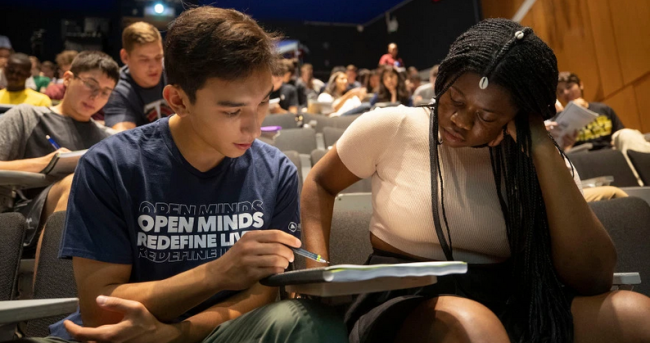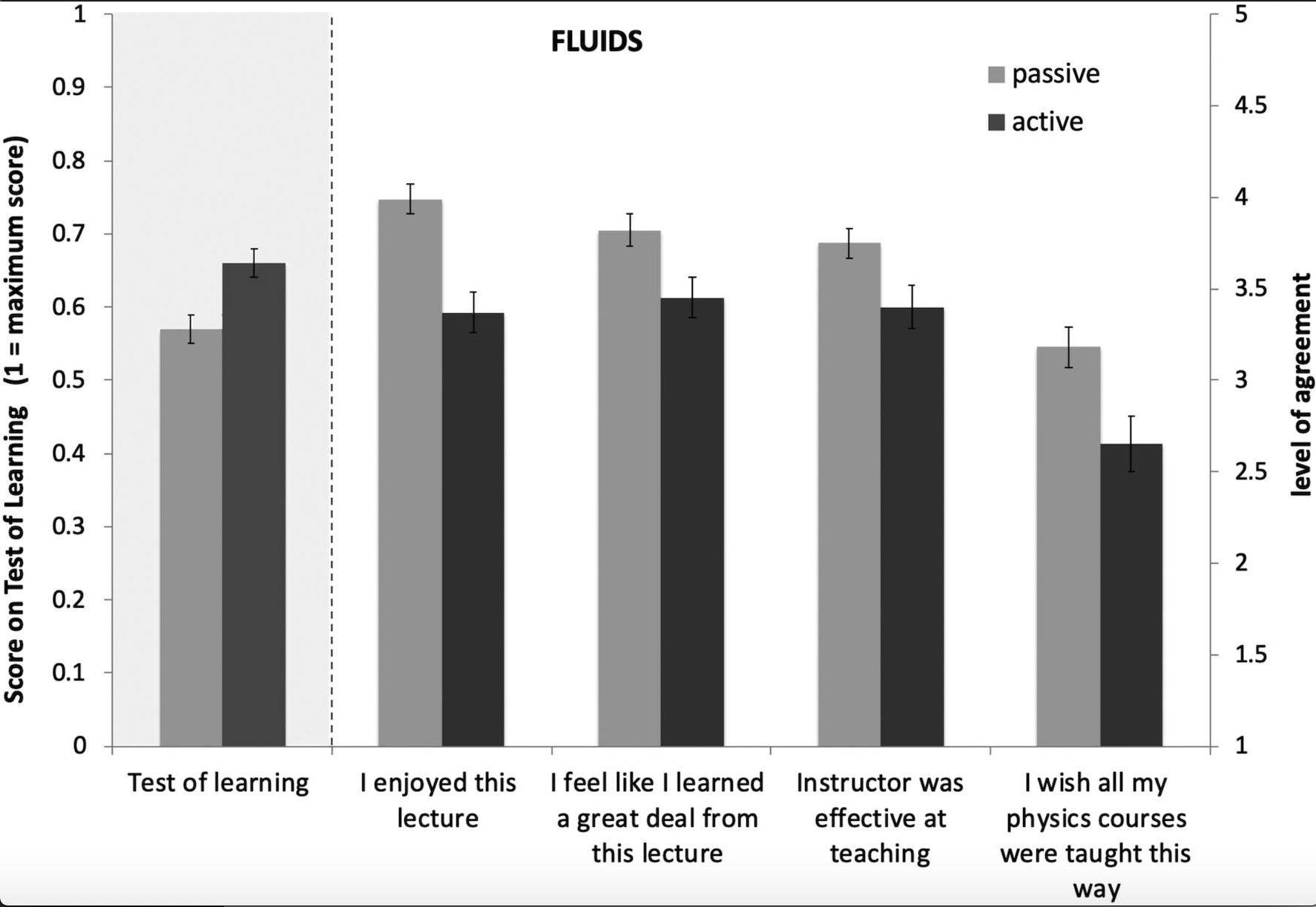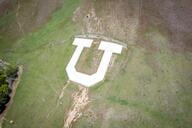You have /5 articles left.
Sign up for a free account or log in.

Sean Finamore (left) and Xaviera Zime study during a lecture in the Science Center at Harvard University
Kris Snibbe / Harvard University
Students who engage in active learning learn more -- but feel like they learn less -- than peers in more lecture-oriented classrooms. That's in part because active learning is harder than more passive learning, according to a new study in Proceedings of the National Academy of Sciences.
Based on their findings, the researchers encourage faculty members to intervene and correct what they call students' "misperception" about how they learn.
"The article does not suggest that students don't like active learning," said lead author Louis Deslauriers, director of science teaching and learning at Harvard University's Faculty of Arts and Sciences and senior preceptor in physics. "In fact the data in the article shows students liked active learning and they felt they learned from it. But it just happened that students felt more positive about a highly-polished version of the same lecture."
Deslauriers's article is called "Measuring Actual Learning Versus Feeling of Learning in Response to Being Actively Engaged in the Classroom." But he said if he'd had his druthers, it might have been called, "The Dangers of Fluent Lectures."
The Study
The study, involving Harvard University undergraduates in large, introductory physics classes, compared students' self reports about what they'd learned with what they'd actually learned, as determined by a multiple choice tests. Students were taught using exactly the same course materials -- a key control that many other studies comparing active versus passive learning have failed to establish. But one group learned via active instruction methods for a week at the end of the semester and the other learned via lectures from experienced and well-regarded instructors.
A "crucial difference" between the two groups, according to the study, was whether students "were told directly how to solve each problem or were first asked to try to solve the problems themselves in small groups."
At the end of the course, students were given both "feeling of learning" and "tests of learning" assessments (the latter consisted of two, low-stakes quizzes with 12 multiple choice questions each). All of the "feeling" responses showed a consistent student preference for the passive lecture environment while scores on the learning tests -- on statics and fluids -- were significantly higher in the active classroom.

Source: Louis Deslauriers
The findings suggest that "attempts to evaluate instruction based on students' perceptions of learning could inadvertently promote inferior (passive) pedagogical methods," the study says. A "superstar" lecturer could make some students feel good about learning at the expense of demonstrably more effective active experiences. But most importantly, the study says, "these results suggest that when students experience the increased cognitive effort associated with active learning, they initially take that effort to signify poorer learning." And that may have a negative effect on their "motivation, engagement, and ability to self-regulate their own learning."
Although students can, on their own, "discover the increased value of being actively engaged during a semester-long course," the researchers argue, "their learning may be impaired during the initial part of the course."
Students' Attitudes and Expectations
The paper also provides important insight into why active learning hasn't taken deeper root in academe, despite the many studies that have previously identified its effectiveness as compared to more passive approaches (namely the lecture). In a word: students. That is, while professors are often seen as the biggest impediments to innovative teaching, the study describes an "inherent student bias against active learning that can limit its effectiveness and may hinder the wide adoption of these methods."
Compared with students in traditional lectures, students in active classes perceived that they learned less, while in reality they learned more. Students also rated the quality of instruction in passive lectures more highly, and expressed a preference to have "all of their physics classes taught this way," despite their lower test scores.
The paper has already generated much discussion among faculty members and teaching and learning staff members. It's been praised for its methodology -- including strong controls -- but also picked on a bit. Clarissa Sorensen-Unruh, instructor of chemistry at Central New Mexico Community College and moderator of the Reflective Teaching Evolution blog, said she'd really hoped that the paper would verify "something we, as active learning professors teaching science, already know: students resist active learning in the classroom because they feel like they are learning less." But she said the statistical analysis left her wanting more, especially as the central finding was the negative correlation between what students learned and how they felt about it.
Another critique is that the researchers used decidedly in-the-box multiple choice-style questions to assess student learning.
Asked about this, Deslauriers said he's come across academics throughout his career who "seem to believe multiple choice exams can only test low-level skills" or knowledge, "but there's a large body of literature showing that it isn't true." In physics education, for example, he said the two "most well-known and robust" assessments -- the Force Concept Inventory and Brief Electricity and Magnetism Assessment -- are multiple choice, conceptual tests of learning that test higher-order thinking, not just facts.
Joshua Eyler, director of faculty development at the University of Mississippi and author of How Humans Learn: The Science and Stories Behind Effective Teaching, said the study is significant and solid in its design, and that he wasn't bothered by multiple choice because such questions "can be complex, too."
In some ways, he said, "the study confirms what we have suspected anecdotally for a long time -- that students feel more comfortable in a lecture environment and believe that they are learning more because of the expectations they have for a college learning environment." But, in fact, he said, they're "actually learning more in the environments where they are actively engaged in building knowledge about key concepts."
As for whether he thought the findings were generalizable beyond physics, Eyler said yes, because of the study's "authenticity." Our brains are good at making distinctions between "authentic learning environments," he said, with meaningful application of knowledge and relevant examples, and more "artificial environments."
A Little Lecturing is Fine
Lecturing from "start to finish falls into that second camp," Eyler said.
At the same time, Eyler stressed that existing literature shows that some limited lecturing is "definitely OK," as "students need to know content in order to engage in higher order thinking."
Asked whether college students are really part of the resistance against ending the nonstop lecturing, Eyler said it's "baked into the tradition of higher education, and that tradition is hard to change." And yet, he said, students bring their experiences and expectations to their colleges and university experiences -- including those about lecturing.
Students' expectations, of course, bear on how they evaluate their professors, as well. And while students in the study said they like active learning, could their often false perceptions about how much they'd learned negatively impact professors who'd actually taught them more, via active learning methods? Deslauriers said that in each of the dozen courses he and colleagues have worked to transform to active learning at Harvard, students' course ratings actually increased significantly. The same is true for courses he's worked on elsewhere, he said.
His message to professors concerned about this, he said, is, "If you use active properly, your students will learn more and they will enjoy and appreciate it, especially once they see evidence of their learning. It just turns out that a superstar traditional lecturer might provide such a high feeling-of-learning that they will be able to compete or even get higher student evaluations."
At the end of their study, to learn more about students' perceptions, Deslauriers and his colleagues conducted follow-up, one-on-one, structured interviews with 17 students from the study. More found the active classrooms "disjointed and lacking in flow when compared with the more fluent passive lecture," the study says. "Students also cited the frequent interruptions that accompanied each transition from group activities to instructor feedback (14 responses), a concern that their errors made during class would not be corrected (10 responses), and a general feeling of frustration and confusion (14 responses) when discussing their concerns about the actively taught classes." No students objected to working groups. But all but one of the students found the passive lecture more "enjoyable and easier to follow."
An Early Intervention
After viewing the study's results, 14 of the 17 students said they imagined they would impact the way they studied.
The study also finds some evidence to support the notion that "novice students are poor at judging their actual learning and thus rely on inaccurate metacognitive cues such as fluency of instruction when they attempt to assess their own learning." Another factor could be little to no prior exposure to fully student-centered classrooms in a college environment.
Could these attitudes be changed? The authors carried out a semester-long intervention to see. Near the beginning of a physics course that used the same active learning strategy, the instructor gave a 20-minute talk on active learning and its effectiveness. At the end of the semester, more than 65 percent of students said in a survey that their feelings about the effectiveness of active learning significantly improved over the course of the semester. Seventy-five percent of students said that the early intervention helped them feel better about active learning during lectures. Lesson learned? If you want your students to appreciate active learning, lecture them about it -- a bit.
Deslauriers’s assurances about student evaluations of teaching notwithstanding, Viji Sathy, teaching professor in psychology at the University of North Carolina at Chapel Hill, said there are “ramifications for faculty when students are dissatisfied,” or, in assessment speak, “indirect measures.” So beyond the intervention explored in the paper, Sathy said she’d like to see institutions, "particularly ones that are promoting active learning and nudging their faculty to do so,” to really consider the “hit” indirect measures may take as a result of moving towards active learning.
"This is an institution’s vote of confidence that the student is up to task of a rigorous course,” she said. It’s "not enough to warn instructors it might happen and encourage them to be transparent with students.”





